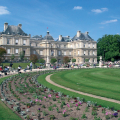PALAIS DU LUXEMBOURG - SÉNAT
A palace built by the architect Salomon de Brosse in a superb eponymous garden, containing a remarkable heritage complex
Commissioned in 1615 by Marie de Médicis, the Palais du Luxembourg was built by architect Salomon de Brosse. Around ten years later, the regent moved in. From its very beginnings, the Palais du Luxembourg has been an integral part of France's political history. It was here that the King's Privy Council was held, and where the fierce power struggles between Louis XIII, Marie de Médicis, and Richelieu took place... Forced to leave the palace following the "Day of the Dupes" (November 1630), Marie de Médicis (banished by her son, to be precise) never saw it completed. However, she bequeathed it to her second son, Gaston duc d'Orléans. The building became known as the "Palais d'Orléans" before reverting to Louis XIV in 1694 through a series of successions. Like the superb eponymous garden in which it is set, it takes its name from the Piney-Luxembourg family. The site on which it was built belonged almost a century earlier to François de Piney, Duke of Luxembourg. Transformed into a prison during the French Revolution, the Palais Médicis became home to the first senators in 1804, with new fittings designed by Jean-François Chalgrin. This "Conservative Senate" was responsible for approving Napoleon's decisions. When the emperor fell, it was replaced by the "Chambre des pairs", while in 1836, Louis Philippe had the palace enlarged to give it the appearance we know today. It was here that General de Gaulle created the Fifth Republic in 1958 and re-established the Senate in its current form. Located in the northern part of the Luxembourg Gardens, the building's architecture is sober and regular, imitating the style of the Tuscan palaces of Marie de Medici's time, while retaining a French touch. Elevations reminiscent of Florence's Pitti Palace, far from the decorative flourishes of the French style, combine with volumes from the French Renaissance château tradition. This unique palace, made up of eight square pavilions, also boasts a remarkable heritage: the Salon des Messagers d'Etat, the Salle des Conférences with its Second Empire decor, the Galerie des bustes, the Hemicycle, the Salle du Livre d'Or, featuring elements of the palace's original decoration, the earliest of which date back to the 1620s, notably those in the Galerie de la reine commissioned from Rubens and depicting the deeds of Marie de Médicis and Henri IV.
Did you know? This review was written by our professional authors.
The strengths of this establishment:
Members' reviews on PALAIS DU LUXEMBOURG - SÉNAT
The ratings and reviews below reflect the subjective opinions of members and not the opinion of The Little Witty.















